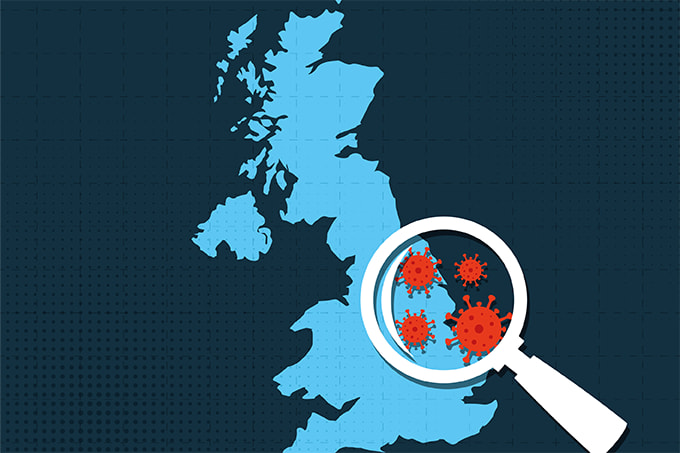How has the COVID-19 pandemic affected your work?
In normal times, as a medical microbiologist and microbiology laboratory director, my employment encompasses all infectious disease clinical testing. The pandemic forced us to drop this broad remit and focus intensely on COVID-19 diagnostics. We had to be on top of every detail of the testing process, not least all aspects of inventory – from nasopharyngeal swabs and transport medias to assay consumables like pipette tips. Usually, the procurement of such items is trivial; with the advent of COVID-19 and the associated supply chain disruption, however, contingency planning for inventory shortfalls in these areas became a daily necessity.
Has the pandemic affected patterns of circulating respiratory pathogens?
Initially, severe restrictions in the supply of tests and related consumables demanded that we confine our activities to COVID-19 diagnostics. But, as consumable supplies normalized and multiplex assay options became available, we expanded our testing activities and made some interesting observations. Notably, we found that influenza and respiratory syncytial virus (RSV) had virtually disappeared; by contrast, human rhinovirus/ enterovirus and adenoviruses – despite masking and social distancing – were still present in the population and were co-circulating with SARS-CoV-2. And the situation continues to evolve – we are now witnessing the reemergence of other respiratory viruses, such as RSV, parainfluenza, and common cold-type coronaviruses. I suspect that the end of social distancing and masking mandates is allowing these classic respiratory viruses to resume circulation.

Do you have any concerns for the forthcoming respiratory infection season?
Most concerning are the resurgences of influenza A, influenza B, and RSV. Prepandemic, these respiratory pathogens were significant causes of morbidity and mortality in certain patient populations; as they reemerge, they will cause the same health issues they did before their circulation was interrupted by COVID-19 lockdowns. Indeed, the reappearance of these pathogens is already apparent; data relating to national viral infection rates indicate recent outbreaks of RSV and parainfluenza in some parts of the country. I also expect influenza to reemerge and increase in frequency this winter. The forthcoming respiratory infection season could look similar to those we experienced prior to the pandemic, but only time will tell.

What challenges did you encounter in respiratory diagnostics during the pandemic?
In addition to supply chain issues, we found that significant difficulties arose when we attempted to discriminate between COVID-19 and other common respiratory pathogens, such as flu and RSV. There is simply no way to distinguish between these infections based on the symptoms they cause. This is a problem because, if hospitals are to effectively manage patients who have respiratory symptoms but are COVID-19 negative, we must determine which of the other common respiratory pathogens is the causative agent. In our laboratory, we address this challenge with a suite of diagnostic tools comprising i) a large, automated testing platform offering a dedicated SARS-CoV-2 assay; ii) a four-plex assay system for influenza A, influenza B, RSV, and SARS-CoV-2; and iii) a multiplex respiratory pathogen panel – the BioFire RP2.1 Panel. Overall, our experience is that a multiplex pathogen test is the most valuable tool for assessment of symptomatic patients. By contrast, a dedicated COVID-19 assay is more useful when the goal is to identify asymptomatic SARS-CoV-2 infections that could spread to other people or result in poor patient outcomes; accordingly, we use the COVID-19 assay for pre-procedural testing and screening of asymptomatic patients.
What are the key features of an ideal diagnostic test for respiratory pathogens?
First, very high sensitivity and specificity, so that we can have high confidence in the test results. Second, speed; turnaround time should be as rapid as possible to allow clinical teams to act on diagnostic findings in real time. Finally, the ideal test should have broad coverage – that is, it should incorporate a range of analytes specific to the most common respiratory pathogens. Remember, COVID-19 looks very similar to diseases caused by other common respiratory pathogens, such as flu and RSV – we cannot separate these conditions on the basis of their symptoms. Therefore, an initial test that can rule in (or rule out) the most common causes of respiratory infections is useful, especially in hospitalized patients with upper respiratory tract symptoms.

Furthermore, by simultaneously testing for a range of common respiratory pathogens, we save time and resources and help clinical teams move forward with a rational treatment plan earlier than might otherwise be possible. The BioFire® Respiratory 2.1 (RP 2.1) Panel is a good example of this syndromic approach in that it covers many of the most common causes of respiratory infection (including COVID-19), helps laboratories optimize their testing strategies, and provides the clinical team with a rapid and accurate result. The BioFire panel will meet the needs of many laboratories while guiding rapid treatment decisions and thus will ultimately be of benefit to patients.




